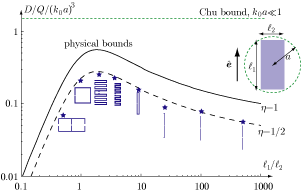Research
Physical bounds in antenna theory
2003-01-01 -> 2008-12-31
Research
Background
The concept of physical bounds (or physical limitations) for electrically small antennas was first introduced more than half a century ago by Wheeler and Chu [1]. Since then, much attention has been drawn to the subject. Unfortunately, almost all results are restricted to the sphere via the spherical vector wave expansions, only deviating marginally from the ideas introduced by Chu in 1948.
In contrast to the approach by Chu, the general bounds analyzed here are solely based on the fundamental principles of primitive causality, time-translational invariance, and reciprocity applied to a general set of linear constitutive relations via a sum rule (the integrated extinction) [2-4].
Theory
The bounds are based on the integrated extinction that is transformed to the antenna identity

where
- k: wavenumber (k=2πf/c0)
- D: directivity
- Γ: reflection coefficient
- η: generalized absorption efficiency (0≤η<1 but often η≈1/2)
- γe: electric polarizability dyadic
- e: (electric) polarization (linear)
- k: direction
Estimate to obtain physical bounds, eg for antennas with a dominate first resonance

where γ∞ denotes the high-contrast polarizability dyadic of a circumscribing geometry.
Illustrations
Circumscribing rectangles

The physical bound on D/Q for the planar rectangle with side lengths l1 and l2 and polarization parallel with the l1 side. Numerical results of various antennas circumscribed by rectangles and the Chu bound are included for comparison.
Circumscribing cylinders

The physical bound D/Q for the cylinder geometry with polarization parallel and orthogonal to the cylinder axis. Numerical results of various antennas (a loop, two top loaded dipoles, and three dipoles) circumscribed by a cylinder and the Chu bound are included for comparison.
References
- L.J. Chu, Physical limitations of omnidirectional antennas, Journal of Applied Physics, Vol. 19, p.1163-1175, 1948
- M. Gustafsson, C. Sohl, G. Kristensson:
Physical limitations on antennas of arbitrary shape
Proc. Roy. Soc. A, Vol. 463, No. 2086, pp. 2589-2607, 2007. TEAT-7153 - C. Sohl, M. Gustafsson:
A priori estimates on the partial realized gain of ultra-wideband (UWB) antennas
Quart. J. Mech. Appl. Math.,Vol. 61,No. 3, pp. 415-430, 2008. TEAT-7160 - M. Gustafsson, C. Sohl, G. Kristensson:
Illustrations of new physical bounds on linearly polarized antennas
IEEE Trans. Antennas Propagat.,Vol. 57,No. 5, pp. 1319-1327, 2009. - A. Derneryd, M. Gustafsson, G. Kristensson, C. Sohl:
Application of gain-bandwidth bounds on loaded dipole antennas - M. Gustafsson, C. Sohl:
New physical bounds on elliptically polarized antennas
European Conference on Antennas and Propagation, Berlin, Germany, pp. 1-3, 2009-03-23.

